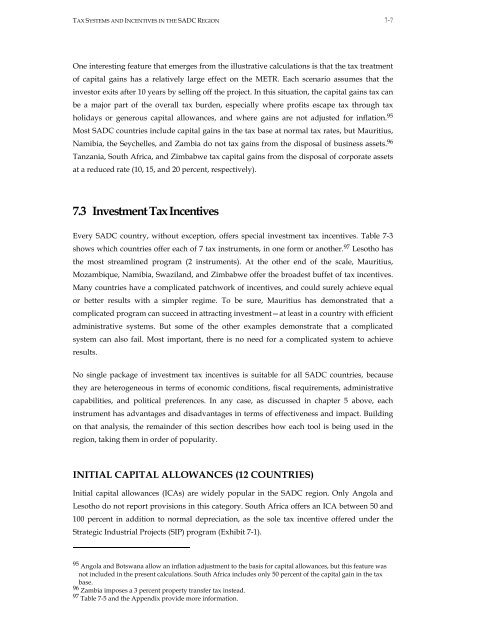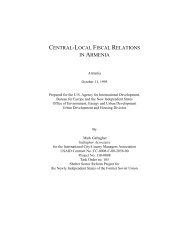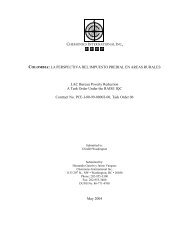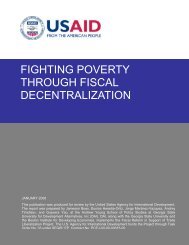Effectiveness and Economic Impact of Tax Incentives in the SADC ...
Effectiveness and Economic Impact of Tax Incentives in the SADC ...
Effectiveness and Economic Impact of Tax Incentives in the SADC ...
Create successful ePaper yourself
Turn your PDF publications into a flip-book with our unique Google optimized e-Paper software.
TAX SYSTEMS AND INCENTIVES IN THE <strong>SADC</strong> REGION 7-7<br />
One <strong>in</strong>terest<strong>in</strong>g feature that emerges from <strong>the</strong> illustrative calculations is that <strong>the</strong> tax treatment<br />
<strong>of</strong> capital ga<strong>in</strong>s has a relatively large effect on <strong>the</strong> METR. Each scenario assumes that <strong>the</strong><br />
<strong>in</strong>vestor exits after 10 years by sell<strong>in</strong>g <strong>of</strong>f <strong>the</strong> project. In this situation, <strong>the</strong> capital ga<strong>in</strong>s tax can<br />
be a major part <strong>of</strong> <strong>the</strong> overall tax burden, especially where pr<strong>of</strong>its escape tax through tax<br />
holidays or generous capital allowances, <strong>and</strong> where ga<strong>in</strong>s are not adjusted for <strong>in</strong>flation. 95<br />
Most <strong>SADC</strong> countries <strong>in</strong>clude capital ga<strong>in</strong>s <strong>in</strong> <strong>the</strong> tax base at normal tax rates, but Mauritius,<br />
Namibia, <strong>the</strong> Seychelles, <strong>and</strong> Zambia do not tax ga<strong>in</strong>s from <strong>the</strong> disposal <strong>of</strong> bus<strong>in</strong>ess assets. 96<br />
Tanzania, South Africa, <strong>and</strong> Zimbabwe tax capital ga<strong>in</strong>s from <strong>the</strong> disposal <strong>of</strong> corporate assets<br />
at a reduced rate (10, 15, <strong>and</strong> 20 percent, respectively).<br />
7.3 Investment <strong>Tax</strong> <strong>Incentives</strong><br />
Every <strong>SADC</strong> country, without exception, <strong>of</strong>fers special <strong>in</strong>vestment tax <strong>in</strong>centives. Table 7-3<br />
shows which countries <strong>of</strong>fer each <strong>of</strong> 7 tax <strong>in</strong>struments, <strong>in</strong> one form or ano<strong>the</strong>r. 97 Lesotho has<br />
<strong>the</strong> most streaml<strong>in</strong>ed program (2 <strong>in</strong>struments). At <strong>the</strong> o<strong>the</strong>r end <strong>of</strong> <strong>the</strong> scale, Mauritius,<br />
Mozambique, Namibia, Swazil<strong>and</strong>, <strong>and</strong> Zimbabwe <strong>of</strong>fer <strong>the</strong> broadest buffet <strong>of</strong> tax <strong>in</strong>centives.<br />
Many countries have a complicated patchwork <strong>of</strong> <strong>in</strong>centives, <strong>and</strong> could surely achieve equal<br />
or better results with a simpler regime. To be sure, Mauritius has demonstrated that a<br />
complicated program can succeed <strong>in</strong> attract<strong>in</strong>g <strong>in</strong>vestment—at least <strong>in</strong> a country with efficient<br />
adm<strong>in</strong>istrative systems. But some <strong>of</strong> <strong>the</strong> o<strong>the</strong>r examples demonstrate that a complicated<br />
system can also fail. Most important, <strong>the</strong>re is no need for a complicated system to achieve<br />
results.<br />
No s<strong>in</strong>gle package <strong>of</strong> <strong>in</strong>vestment tax <strong>in</strong>centives is suitable for all <strong>SADC</strong> countries, because<br />
<strong>the</strong>y are heterogeneous <strong>in</strong> terms <strong>of</strong> economic conditions, fiscal requirements, adm<strong>in</strong>istrative<br />
capabilities, <strong>and</strong> political preferences. In any case, as discussed <strong>in</strong> chapter 5 above, each<br />
<strong>in</strong>strument has advantages <strong>and</strong> disadvantages <strong>in</strong> terms <strong>of</strong> effectiveness <strong>and</strong> impact. Build<strong>in</strong>g<br />
on that analysis, <strong>the</strong> rema<strong>in</strong>der <strong>of</strong> this section describes how each tool is be<strong>in</strong>g used <strong>in</strong> <strong>the</strong><br />
region, tak<strong>in</strong>g <strong>the</strong>m <strong>in</strong> order <strong>of</strong> popularity.<br />
INITIAL CAPITAL ALLOWANCES (12 COUNTRIES)<br />
Initial capital allowances (ICAs) are widely popular <strong>in</strong> <strong>the</strong> <strong>SADC</strong> region. Only Angola <strong>and</strong><br />
Lesotho do not report provisions <strong>in</strong> this category. South Africa <strong>of</strong>fers an ICA between 50 <strong>and</strong><br />
100 percent <strong>in</strong> addition to normal depreciation, as <strong>the</strong> sole tax <strong>in</strong>centive <strong>of</strong>fered under <strong>the</strong><br />
Strategic Industrial Projects (SIP) program (Exhibit 7-1).<br />
95 Angola <strong>and</strong> Botswana allow an <strong>in</strong>flation adjustment to <strong>the</strong> basis for capital allowances, but this feature was<br />
not <strong>in</strong>cluded <strong>in</strong> <strong>the</strong> present calculations. South Africa <strong>in</strong>cludes only 50 percent <strong>of</strong> <strong>the</strong> capital ga<strong>in</strong> <strong>in</strong> <strong>the</strong> tax<br />
base.<br />
96 Zambia imposes a 3 percent property transfer tax <strong>in</strong>stead.<br />
97 Table 7-5 <strong>and</strong> <strong>the</strong> Appendix provide more <strong>in</strong>formation.











